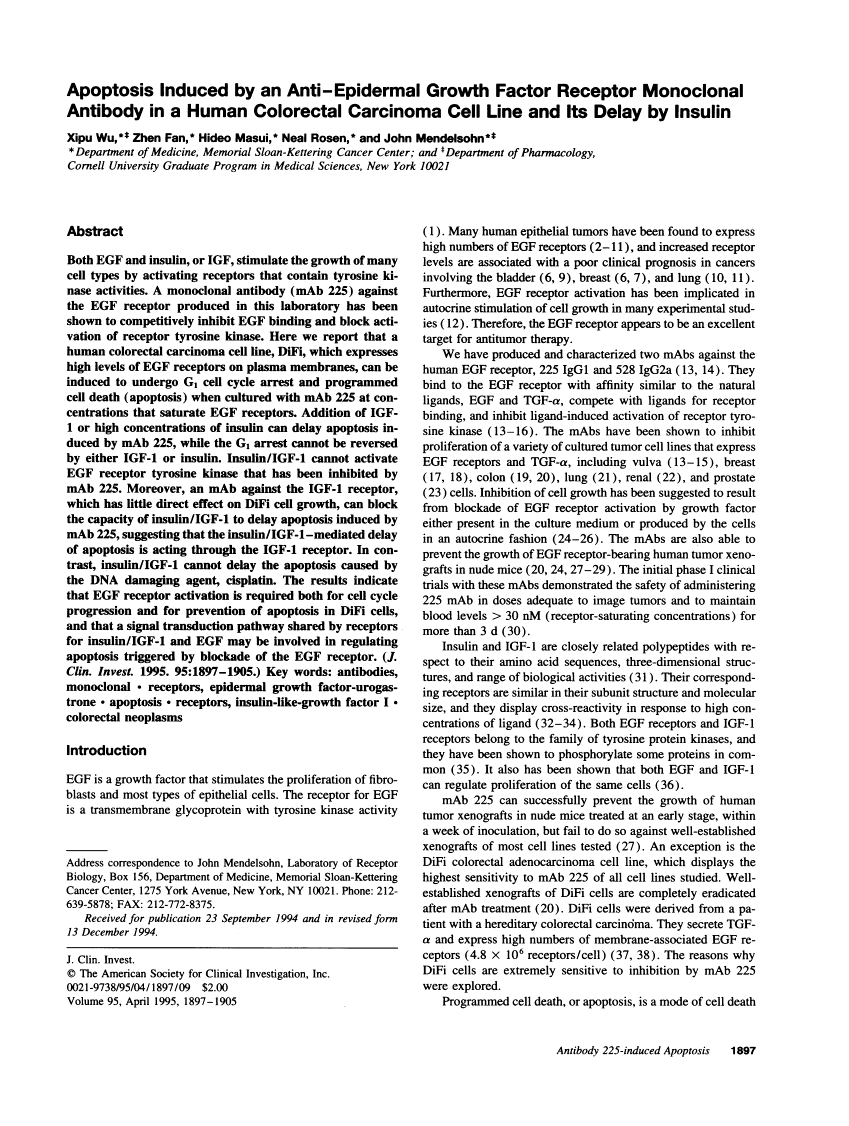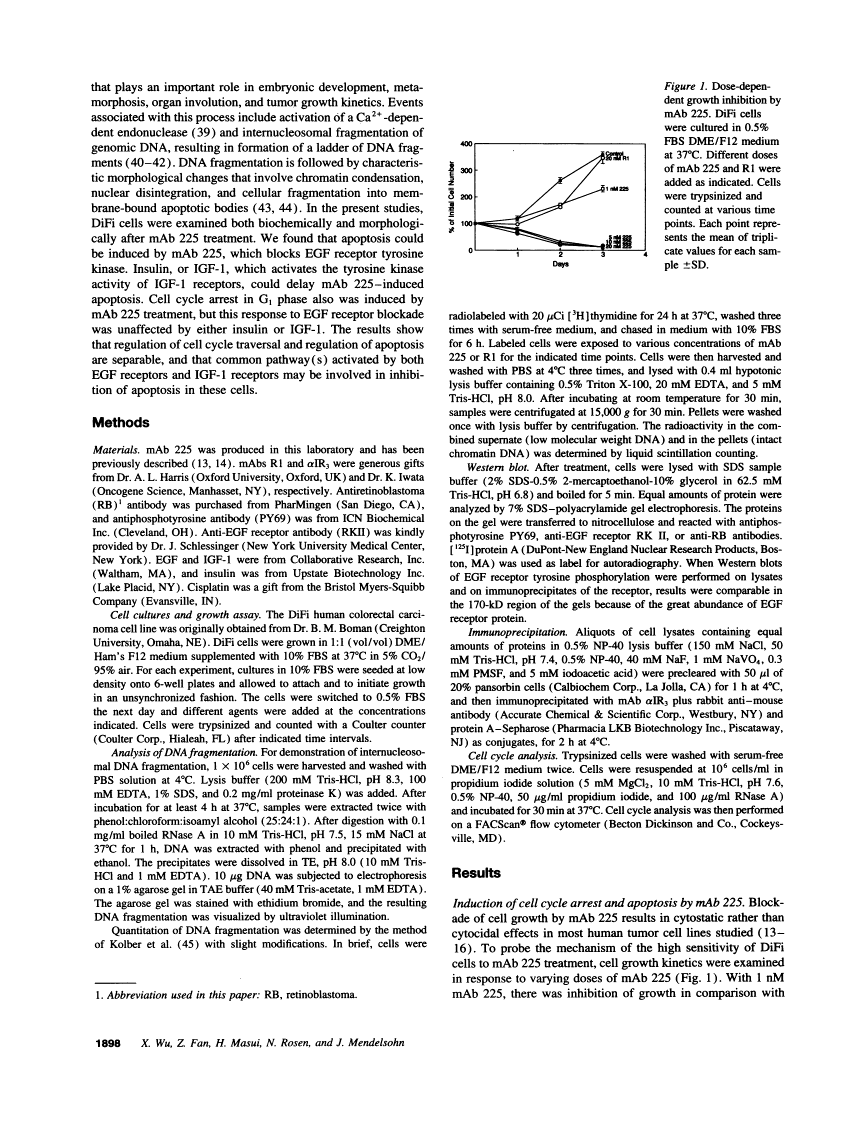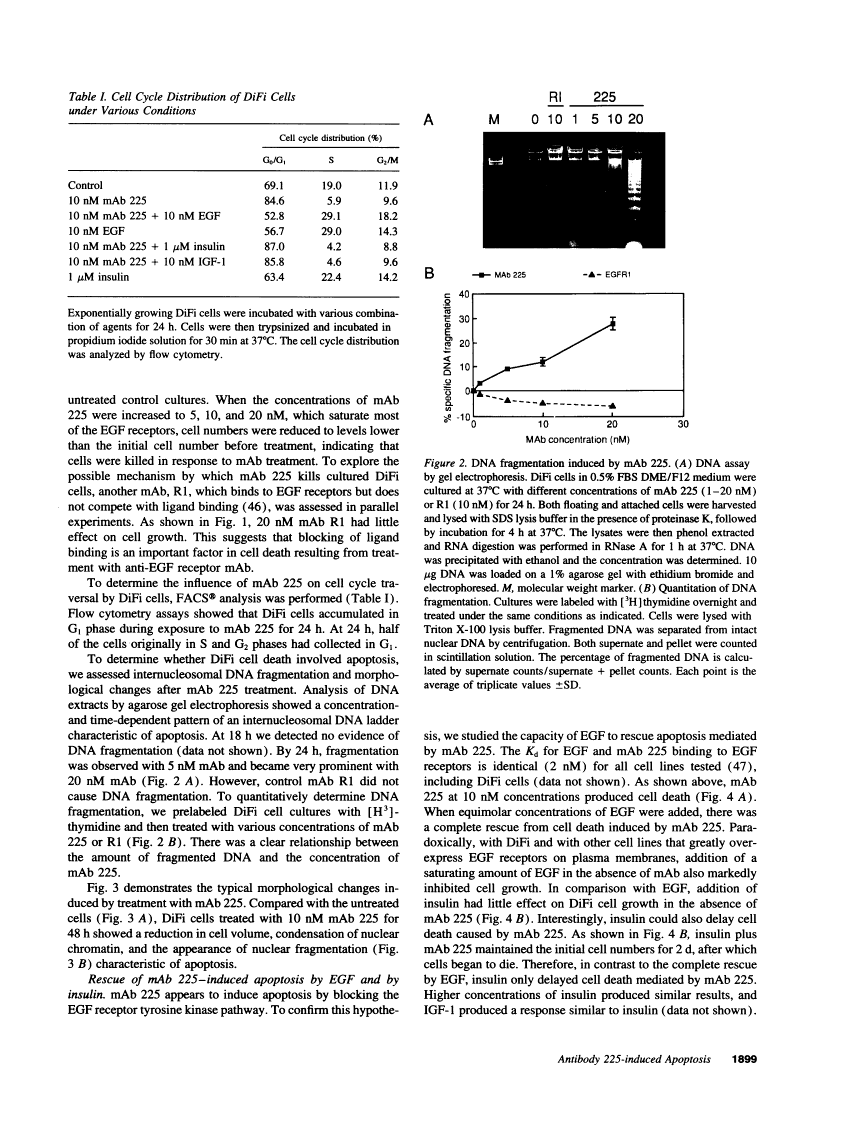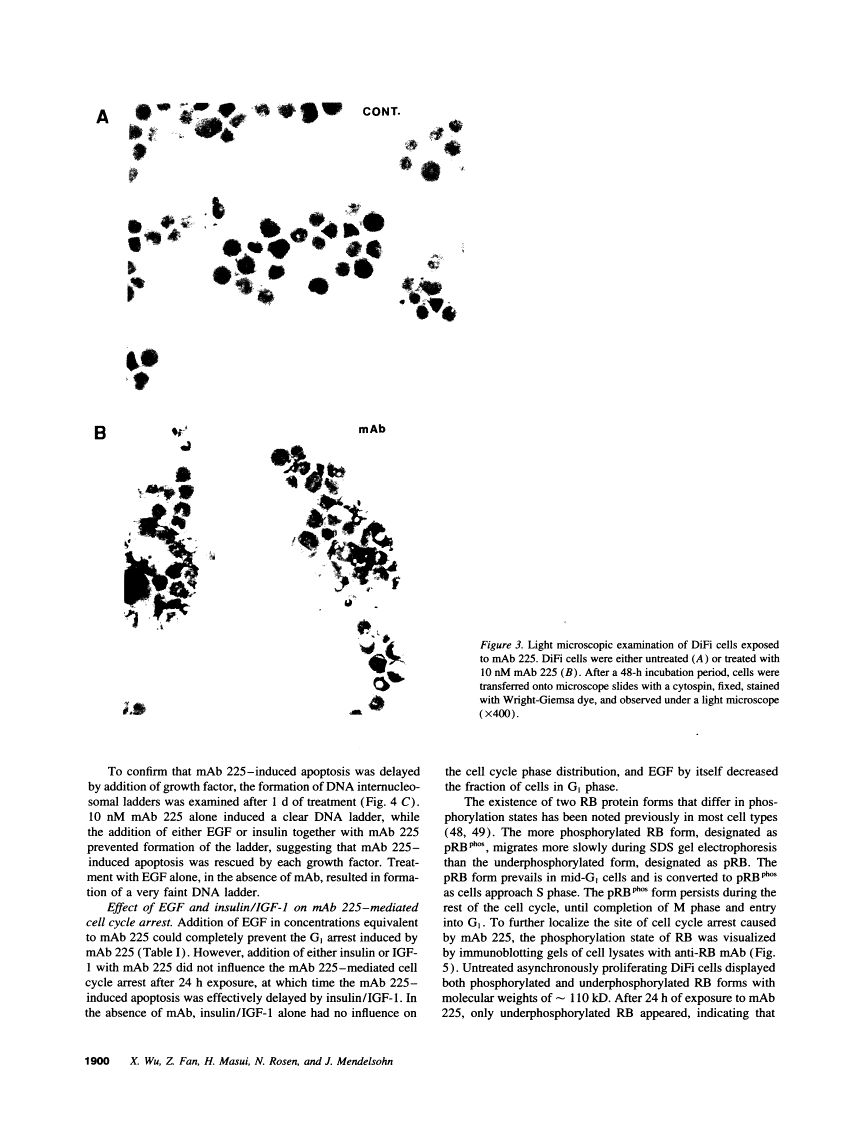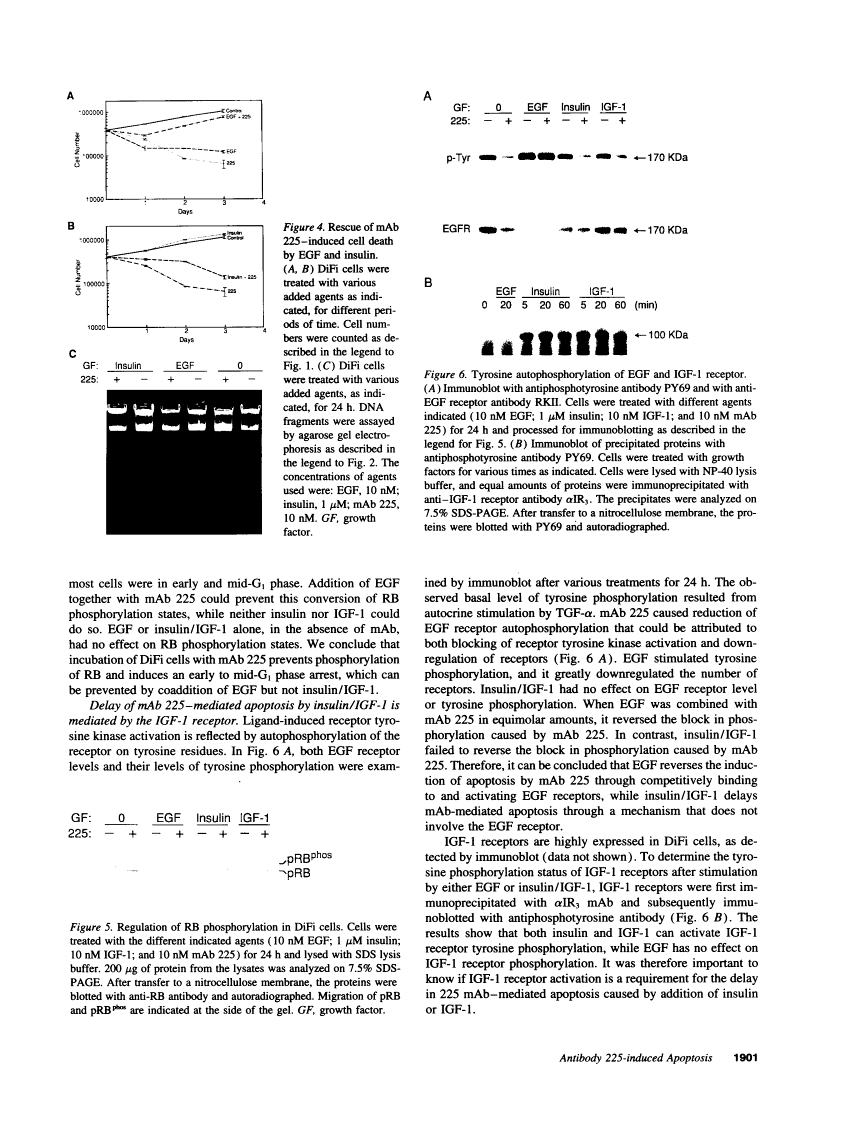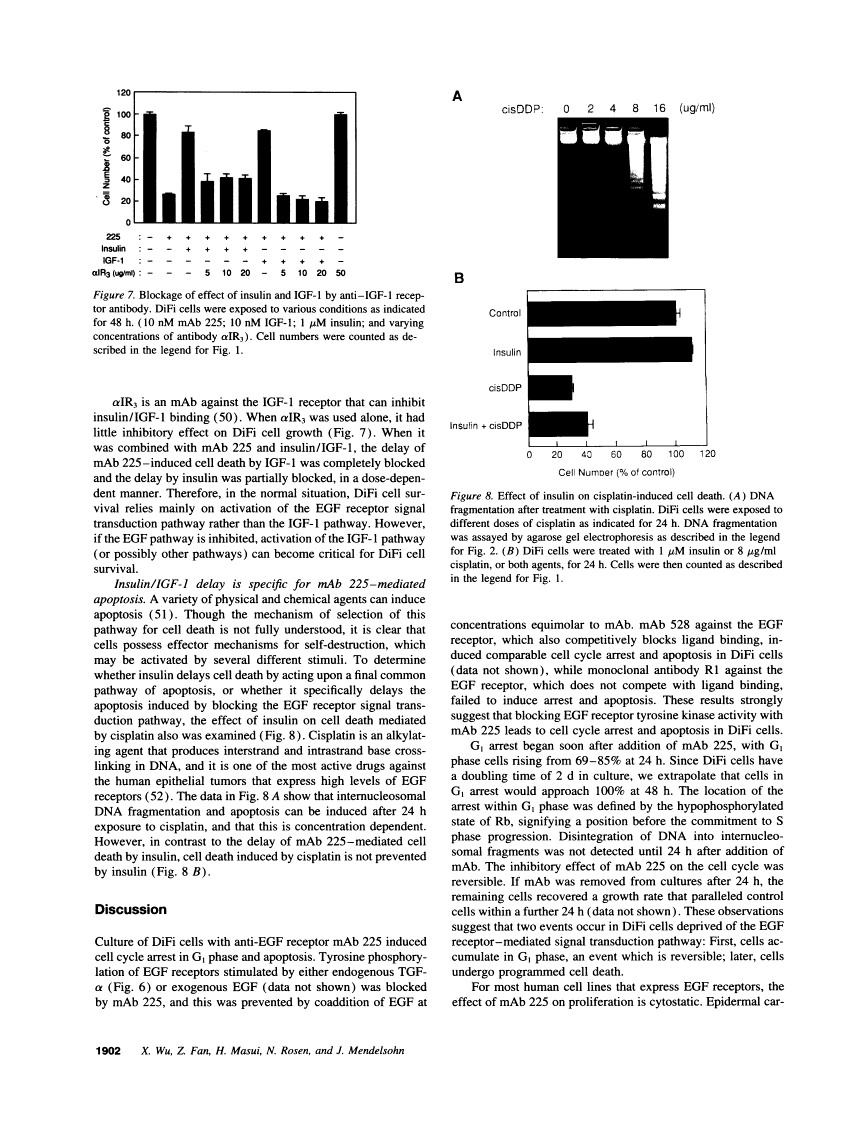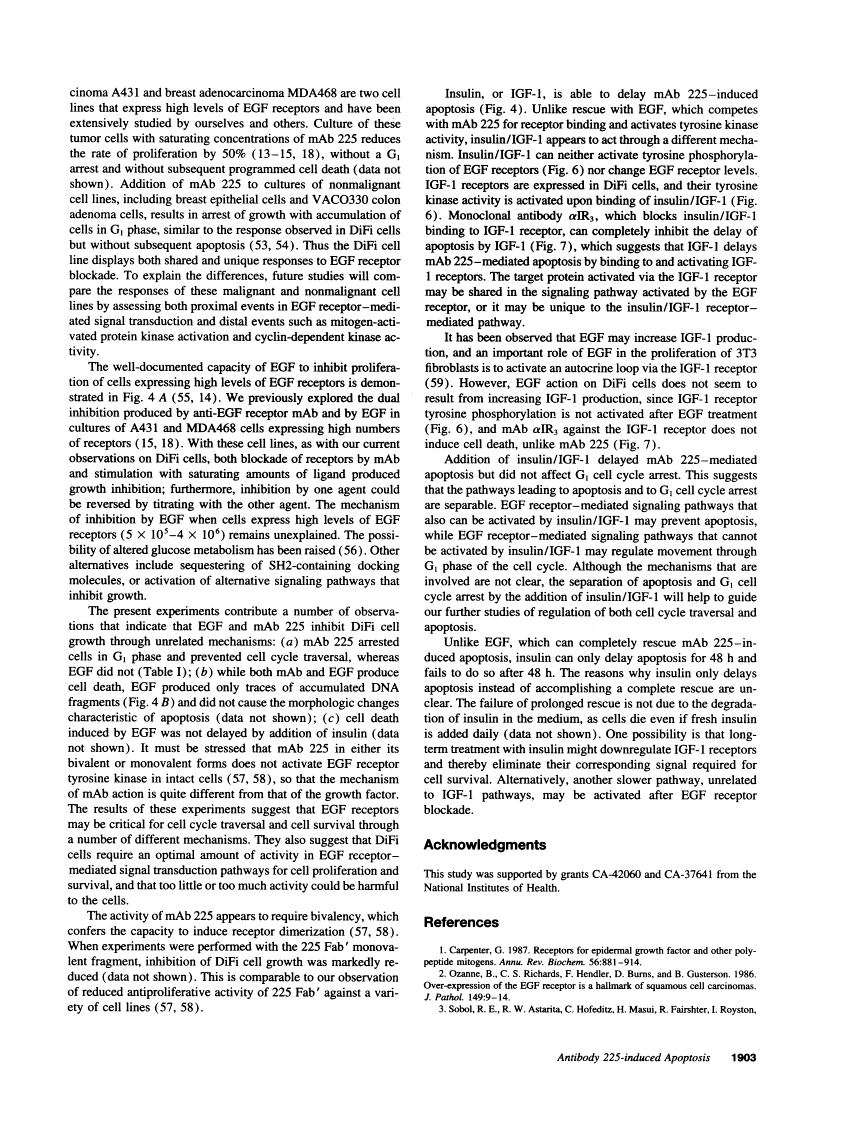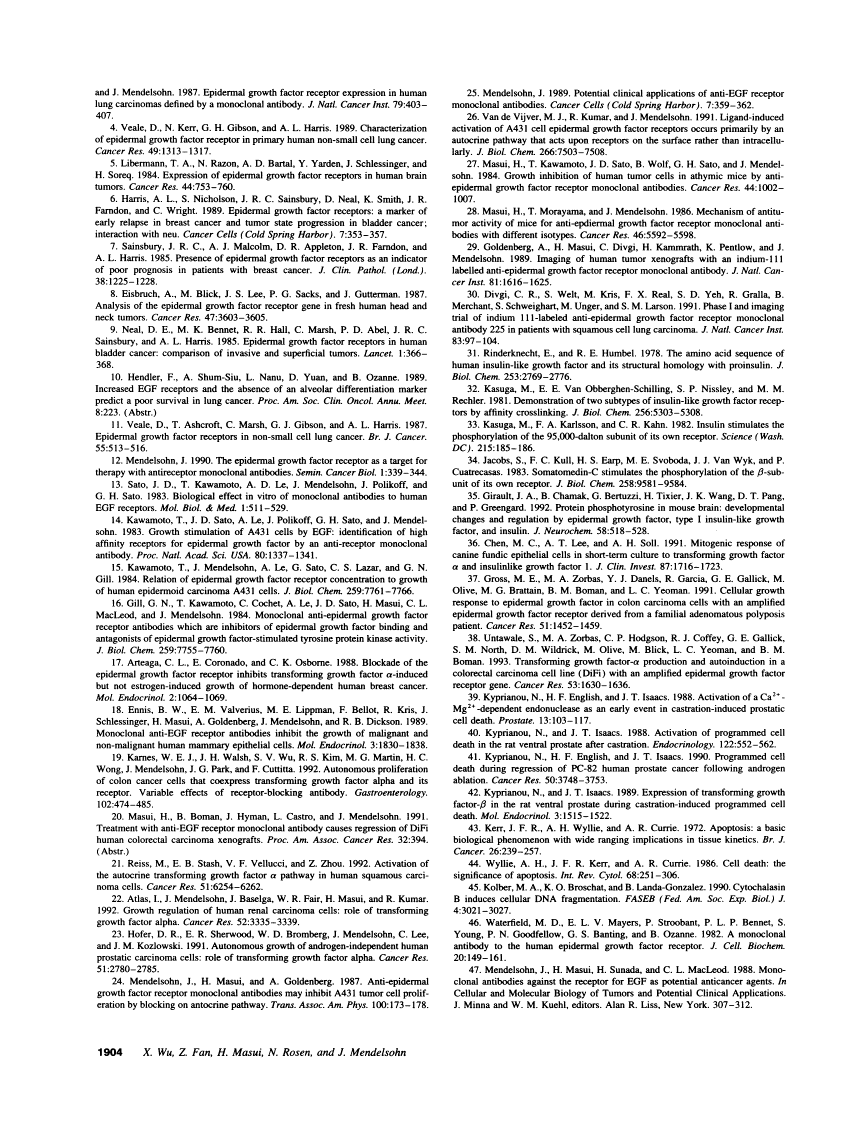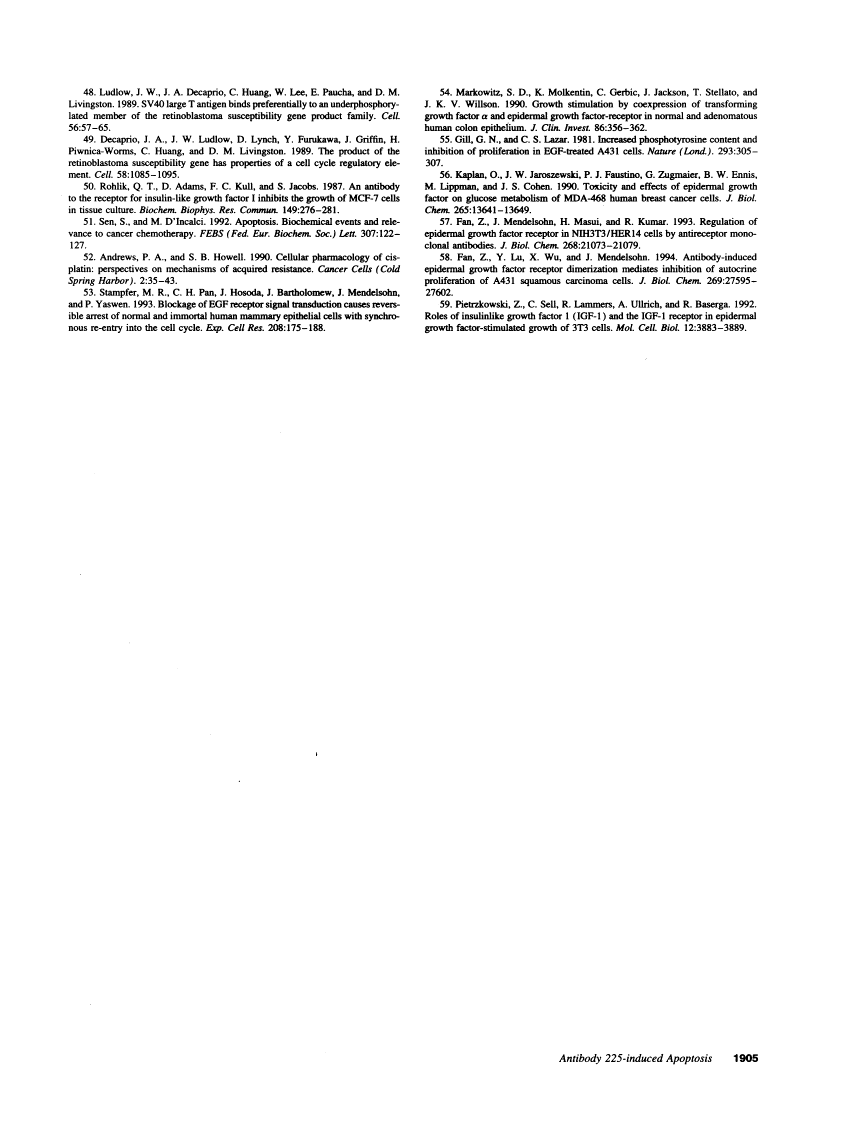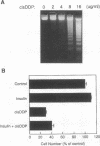Abstract
Free full text

Apoptosis induced by an anti-epidermal growth factor receptor monoclonal antibody in a human colorectal carcinoma cell line and its delay by insulin.
Abstract
Both EGF and insulin, or IGF, stimulate the growth of many cell types by activating receptors that contain tyrosine kinase activities. A monoclonal antibody (mAb 225) against the EGF receptor produced in this laboratory has been shown to competitively inhibit EGF binding and block activation of receptor tyrosine kinase. Here we report that a human colorectal carcinoma cell line, DiFi, which expresses high levels of EGF receptors on plasma membranes, can be induced to undergo G1 cell cycle arrest and programmed cell death (apoptosis) when cultured with mAb 225 at concentrations that saturate EGF receptors. Addition of IGF-1 or high concentrations of insulin can delay apoptosis induced by mAb 225, while the G1 arrest cannot be reversed by either IGF-1 or insulin. Insulin/IGF-1 cannot activate EGF receptor tyrosine kinase that has been inhibited by mAb 225. Moreover, an mAb against the IGF-1 receptor, which has little direct effect on DiFi cell growth, can block the capacity of insulin/IGF-1 to delay apoptosis induced by mAb 225, suggesting that the insulin/IGF-1-mediated delay of apoptosis is acting through the IGF-1 receptor. In contrast, insulin/IGF-1 cannot delay the apoptosis caused by the DNA damaging agent, cisplatin. The results indicate that EGF receptor activation is required both for cell cycle progression and for prevention of apoptosis in DiFi cells, and that a signal transduction pathway shared by receptors for insulin/IGF-1 and EGF may be involved in regulating apoptosis triggered by blockade of the EGF receptor.
Full text
Full text is available as a scanned copy of the original print version. Get a printable copy (PDF file) of the complete article (2.1M), or click on a page image below to browse page by page. Links to PubMed are also available for Selected References.
Images in this article
Click on the image to see a larger version.
Selected References
These references are in PubMed. This may not be the complete list of references from this article.
- Carpenter G. Receptors for epidermal growth factor and other polypeptide mitogens. Annu Rev Biochem. 1987;56:881–914. [Abstract] [Google Scholar]
- Ozanne B, Richards CS, Hendler F, Burns D, Gusterson B. Over-expression of the EGF receptor is a hallmark of squamous cell carcinomas. J Pathol. 1986 May;149(1):9–14. [Abstract] [Google Scholar]
- Sobol RE, Astarita RW, Hofeditz C, Masui H, Fairshter R, Royston I, Mendelsohn J. Epidermal growth factor receptor expression in human lung carcinomas defined by a monoclonal antibody. J Natl Cancer Inst. 1987 Sep;79(3):403–407. [Abstract] [Google Scholar]
- Veale D, Kerr N, Gibson GJ, Harris AL. Characterization of epidermal growth factor receptor in primary human non-small cell lung cancer. Cancer Res. 1989 Mar 1;49(5):1313–1317. [Abstract] [Google Scholar]
- Libermann TA, Razon N, Bartal AD, Yarden Y, Schlessinger J, Soreq H. Expression of epidermal growth factor receptors in human brain tumors. Cancer Res. 1984 Feb;44(2):753–760. [Abstract] [Google Scholar]
- Sainsbury JR, Malcolm AJ, Appleton DR, Farndon JR, Harris AL. Presence of epidermal growth factor receptor as an indicator of poor prognosis in patients with breast cancer. J Clin Pathol. 1985 Nov;38(11):1225–1228. [Europe PMC free article] [Abstract] [Google Scholar]
- Eisbruch A, Blick M, Lee JS, Sacks PG, Gutterman J. Analysis of the epidermal growth factor receptor gene in fresh human head and neck tumors. Cancer Res. 1987 Jul 1;47(13):3603–3605. [Abstract] [Google Scholar]
- Neal DE, Marsh C, Bennett MK, Abel PD, Hall RR, Sainsbury JR, Harris AL. Epidermal-growth-factor receptors in human bladder cancer: comparison of invasive and superficial tumours. Lancet. 1985 Feb 16;1(8425):366–368. [Abstract] [Google Scholar]
- Veale D, Ashcroft T, Marsh C, Gibson GJ, Harris AL. Epidermal growth factor receptors in non-small cell lung cancer. Br J Cancer. 1987 May;55(5):513–516. [Europe PMC free article] [Abstract] [Google Scholar]
- Mendelsohn J. The epidermal growth factor receptor as a target for therapy with antireceptor monoclonal antibodies. Semin Cancer Biol. 1990 Oct;1(5):339–344. [Abstract] [Google Scholar]
- Sato JD, Kawamoto T, Le AD, Mendelsohn J, Polikoff J, Sato GH. Biological effects in vitro of monoclonal antibodies to human epidermal growth factor receptors. Mol Biol Med. 1983 Dec;1(5):511–529. [Abstract] [Google Scholar]
- Kawamoto T, Sato JD, Le A, Polikoff J, Sato GH, Mendelsohn J. Growth stimulation of A431 cells by epidermal growth factor: identification of high-affinity receptors for epidermal growth factor by an anti-receptor monoclonal antibody. Proc Natl Acad Sci U S A. 1983 Mar;80(5):1337–1341. [Europe PMC free article] [Abstract] [Google Scholar]
- Kawamoto T, Mendelsohn J, Le A, Sato GH, Lazar CS, Gill GN. Relation of epidermal growth factor receptor concentration to growth of human epidermoid carcinoma A431 cells. J Biol Chem. 1984 Jun 25;259(12):7761–7766. [Abstract] [Google Scholar]
- Gill GN, Kawamoto T, Cochet C, Le A, Sato JD, Masui H, McLeod C, Mendelsohn J. Monoclonal anti-epidermal growth factor receptor antibodies which are inhibitors of epidermal growth factor binding and antagonists of epidermal growth factor binding and antagonists of epidermal growth factor-stimulated tyrosine protein kinase activity. J Biol Chem. 1984 Jun 25;259(12):7755–7760. [Abstract] [Google Scholar]
- Arteaga CL, Coronado E, Osborne CK. Blockade of the epidermal growth factor receptor inhibits transforming growth factor alpha-induced but not estrogen-induced growth of hormone-dependent human breast cancer. Mol Endocrinol. 1988 Nov;2(11):1064–1069. [Abstract] [Google Scholar]
- Ennis BW, Valverius EM, Bates SE, Lippman ME, Bellot F, Kris R, Schlessinger J, Masui H, Goldenberg A, Mendelsohn J, et al. Anti-epidermal growth factor receptor antibodies inhibit the autocrine-stimulated growth of MDA-468 human breast cancer cells. Mol Endocrinol. 1989 Nov;3(11):1830–1838. [Abstract] [Google Scholar]
- Karnes WE, Jr, Walsh JH, Wu SV, Kim RS, Martin MG, Wong HC, Mendelsohn J, Park JG, Cuttitta F. Autonomous proliferation of colon cancer cells that coexpress transforming growth factor alpha and its receptor. Variable effects of receptor-blocking antibody. Gastroenterology. 1992 Feb;102(2):474–485. [Abstract] [Google Scholar]
- Reiss M, Stash EB, Vellucci VF, Zhou ZL. Activation of the autocrine transforming growth factor alpha pathway in human squamous carcinoma cells. Cancer Res. 1991 Dec 1;51(23 Pt 1):6254–6262. [Abstract] [Google Scholar]
- Atlas I, Mendelsohn J, Baselga J, Fair WR, Masui H, Kumar R. Growth regulation of human renal carcinoma cells: role of transforming growth factor alpha. Cancer Res. 1992 Jun 15;52(12):3335–3339. [Abstract] [Google Scholar]
- Hofer DR, Sherwood ER, Bromberg WD, Mendelsohn J, Lee C, Kozlowski JM. Autonomous growth of androgen-independent human prostatic carcinoma cells: role of transforming growth factor alpha. Cancer Res. 1991 Jun 1;51(11):2780–2785. [Abstract] [Google Scholar]
- Mendelsohn J, Masui H, Goldenberg A. Anti-epidermal growth factor receptor monoclonal antibodies may inhibit A431 tumor cell proliferation by blocking an autocrine pathway. Trans Assoc Am Physicians. 1987;100:173–178. [Abstract] [Google Scholar]
- Van de Vijver MJ, Kumar R, Mendelsohn J. Ligand-induced activation of A431 cell epidermal growth factor receptors occurs primarily by an autocrine pathway that acts upon receptors on the surface rather than intracellularly. J Biol Chem. 1991 Apr 25;266(12):7503–7508. [Abstract] [Google Scholar]
- Masui H, Kawamoto T, Sato JD, Wolf B, Sato G, Mendelsohn J. Growth inhibition of human tumor cells in athymic mice by anti-epidermal growth factor receptor monoclonal antibodies. Cancer Res. 1984 Mar;44(3):1002–1007. [Abstract] [Google Scholar]
- Masui H, Moroyama T, Mendelsohn J. Mechanism of antitumor activity in mice for anti-epidermal growth factor receptor monoclonal antibodies with different isotypes. Cancer Res. 1986 Nov;46(11):5592–5598. [Abstract] [Google Scholar]
- Goldenberg A, Masui H, Divgi C, Kamrath H, Pentlow K, Mendelsohn J. Imaging of human tumor xenografts with an indium-111-labeled anti-epidermal growth factor receptor monoclonal antibody. J Natl Cancer Inst. 1989 Nov 1;81(21):1616–1625. [Abstract] [Google Scholar]
- Divgi CR, Welt S, Kris M, Real FX, Yeh SD, Gralla R, Merchant B, Schweighart S, Unger M, Larson SM, et al. Phase I and imaging trial of indium 111-labeled anti-epidermal growth factor receptor monoclonal antibody 225 in patients with squamous cell lung carcinoma. J Natl Cancer Inst. 1991 Jan 16;83(2):97–104. [Abstract] [Google Scholar]
- Rinderknecht E, Humbel RE. The amino acid sequence of human insulin-like growth factor I and its structural homology with proinsulin. J Biol Chem. 1978 Apr 25;253(8):2769–2776. [Abstract] [Google Scholar]
- Kasuga M, Van Obberghen E, Nissley SP, Rechler MM. Demonstration of two subtypes of insulin-like growth factor receptors by affinity cross-linking. J Biol Chem. 1981 Jun 10;256(11):5305–5308. [Abstract] [Google Scholar]
- Kasuga M, Karlsson FA, Kahn CR. Insulin stimulates the phosphorylation of the 95,000-dalton subunit of its own receptor. Science. 1982 Jan 8;215(4529):185–187. [Abstract] [Google Scholar]
- Jacobs S, Kull FC, Jr, Earp HS, Svoboda ME, Van Wyk JJ, Cuatrecasas P. Somatomedin-C stimulates the phosphorylation of the beta-subunit of its own receptor. J Biol Chem. 1983 Aug 25;258(16):9581–9584. [Abstract] [Google Scholar]
- Girault JA, Chamak B, Bertuzzi G, Tixier H, Wang JK, Pang DT, Greengard P. Protein phosphotyrosine in mouse brain: developmental changes and regulation by epidermal growth factor, type I insulin-like growth factor, and insulin. J Neurochem. 1992 Feb;58(2):518–528. [Abstract] [Google Scholar]
- Chen MC, Lee AT, Soll AH. Mitogenic response of canine fundic epithelial cells in short-term culture to transforming growth factor alpha and insulinlike growth factor I. J Clin Invest. 1991 May;87(5):1716–1723. [Europe PMC free article] [Abstract] [Google Scholar]
- Gross ME, Zorbas MA, Danels YJ, Garcia R, Gallick GE, Olive M, Brattain MG, Boman BM, Yeoman LC. Cellular growth response to epidermal growth factor in colon carcinoma cells with an amplified epidermal growth factor receptor derived from a familial adenomatous polyposis patient. Cancer Res. 1991 Mar 1;51(5):1452–1459. [Abstract] [Google Scholar]
- Untawale S, Zorbas MA, Hodgson CP, Coffey RJ, Gallick GE, North SM, Wildrick DM, Olive M, Blick M, Yeoman LC, et al. Transforming growth factor-alpha production and autoinduction in a colorectal carcinoma cell line (DiFi) with an amplified epidermal growth factor receptor gene. Cancer Res. 1993 Apr 1;53(7):1630–1636. [Abstract] [Google Scholar]
- Kyprianou N, English HF, Isaacs JT. Activation of a Ca2+-Mg2+-dependent endonuclease as an early event in castration-induced prostatic cell death. Prostate. 1988;13(2):103–117. [Abstract] [Google Scholar]
- Kyprianou N, Isaacs JT. Activation of programmed cell death in the rat ventral prostate after castration. Endocrinology. 1988 Feb;122(2):552–562. [Abstract] [Google Scholar]
- Kyprianou N, English HF, Isaacs JT. Programmed cell death during regression of PC-82 human prostate cancer following androgen ablation. Cancer Res. 1990 Jun 15;50(12):3748–3753. [Abstract] [Google Scholar]
- Kyprianou N, Isaacs JT. Expression of transforming growth factor-beta in the rat ventral prostate during castration-induced programmed cell death. Mol Endocrinol. 1989 Oct;3(10):1515–1522. [Abstract] [Google Scholar]
- Kerr JF, Wyllie AH, Currie AR. Apoptosis: a basic biological phenomenon with wide-ranging implications in tissue kinetics. Br J Cancer. 1972 Aug;26(4):239–257. [Europe PMC free article] [Abstract] [Google Scholar]
- Wyllie AH, Kerr JF, Currie AR. Cell death: the significance of apoptosis. Int Rev Cytol. 1980;68:251–306. [Abstract] [Google Scholar]
- Kolber MA, Broschat KO, Landa-Gonzalez B. Cytochalasin B induces cellular DNA fragmentation. FASEB J. 1990 Sep;4(12):3021–3027. [Abstract] [Google Scholar]
- Waterfield MD, Mayes EL, Stroobant P, Bennet PL, Young S, Goodfellow PN, Banting GS, Ozanne B. A monoclonal antibody to the human epidermal growth factor receptor. J Cell Biochem. 1982;20(2):149–161. [Abstract] [Google Scholar]
- Ludlow JW, DeCaprio JA, Huang CM, Lee WH, Paucha E, Livingston DM. SV40 large T antigen binds preferentially to an underphosphorylated member of the retinoblastoma susceptibility gene product family. Cell. 1989 Jan 13;56(1):57–65. [Abstract] [Google Scholar]
- DeCaprio JA, Ludlow JW, Lynch D, Furukawa Y, Griffin J, Piwnica-Worms H, Huang CM, Livingston DM. The product of the retinoblastoma susceptibility gene has properties of a cell cycle regulatory element. Cell. 1989 Sep 22;58(6):1085–1095. [Abstract] [Google Scholar]
- Rohlik QT, Adams D, Kull FC, Jr, Jacobs S. An antibody to the receptor for insulin-like growth factor I inhibits the growth of MCF-7 cells in tissue culture. Biochem Biophys Res Commun. 1987 Nov 30;149(1):276–281. [Abstract] [Google Scholar]
- Sen S, D'Incalci M. Apoptosis. Biochemical events and relevance to cancer chemotherapy. FEBS Lett. 1992 Jul 27;307(1):122–127. [Abstract] [Google Scholar]
- Andrews PA, Howell SB. Cellular pharmacology of cisplatin: perspectives on mechanisms of acquired resistance. Cancer Cells. 1990 Feb;2(2):35–43. [Abstract] [Google Scholar]
- Stampfer MR, Pan CH, Hosoda J, Bartholomew J, Mendelsohn J, Yaswen P. Blockage of EGF receptor signal transduction causes reversible arrest of normal and immortal human mammary epithelial cells with synchronous reentry into the cell cycle. Exp Cell Res. 1993 Sep;208(1):175–188. [Abstract] [Google Scholar]
- Markowitz SD, Molkentin K, Gerbic C, Jackson J, Stellato T, Willson JK. Growth stimulation by coexpression of transforming growth factor-alpha and epidermal growth factor-receptor in normal and adenomatous human colon epithelium. J Clin Invest. 1990 Jul;86(1):356–362. [Europe PMC free article] [Abstract] [Google Scholar]
- Gill GN, Lazar CS. Increased phosphotyrosine content and inhibition of proliferation in EGF-treated A431 cells. Nature. 1981 Sep 24;293(5830):305–307. [Abstract] [Google Scholar]
- Kaplan O, Jaroszewski JW, Faustino PJ, Zugmaier G, Ennis BW, Lippman M, Cohen JS. Toxicity and effects of epidermal growth factor on glucose metabolism of MDA-468 human breast cancer cells. J Biol Chem. 1990 Aug 15;265(23):13641–13649. [Abstract] [Google Scholar]
- Fan Z, Mendelsohn J, Masui H, Kumar R. Regulation of epidermal growth factor receptor in NIH3T3/HER14 cells by antireceptor monoclonal antibodies. J Biol Chem. 1993 Oct 5;268(28):21073–21079. [Abstract] [Google Scholar]
- Fan Z, Lu Y, Wu X, Mendelsohn J. Antibody-induced epidermal growth factor receptor dimerization mediates inhibition of autocrine proliferation of A431 squamous carcinoma cells. J Biol Chem. 1994 Nov 4;269(44):27595–27602. [Abstract] [Google Scholar]
- Pietrzkowski Z, Sell C, Lammers R, Ullrich A, Baserga R. Roles of insulinlike growth factor 1 (IGF-1) and the IGF-1 receptor in epidermal growth factor-stimulated growth of 3T3 cells. Mol Cell Biol. 1992 Sep;12(9):3883–3889. [Europe PMC free article] [Abstract] [Google Scholar]
Associated Data
Articles from The Journal of Clinical Investigation are provided here courtesy of American Society for Clinical Investigation
Full text links
Read article at publisher's site: https://doi.org/10.1172/jci117871
Read article for free, from open access legal sources, via Unpaywall:
http://www.jci.org/articles/view/117871/files/pdf
Citations & impact
Impact metrics
Article citations
Recruiting In Vitro Transcribed mRNA against Cancer Immunotherapy: A Contemporary Appraisal of the Current Landscape.
Curr Issues Mol Biol, 45(11):9181-9214, 16 Nov 2023
Cited by: 2 articles | PMID: 37998753 | PMCID: PMC10670245
Review Free full text in Europe PMC
Genetically proxied glucose-lowering drug target perturbation and risk of cancer: a Mendelian randomisation analysis.
Diabetologia, 66(8):1481-1500, 12 May 2023
Cited by: 11 articles | PMID: 37171501 | PMCID: PMC10317892
Post-translational covalent assembly of CAR and synNotch receptors for programmable antigen targeting.
Nat Commun, 14(1):2463, 09 May 2023
Cited by: 27 articles | PMID: 37160880 | PMCID: PMC10169838
Effect of insulin resistance on CAC scores in cancer survivors.
Cardiooncology, 9(1):21, 14 Apr 2023
Cited by: 0 articles | PMID: 37060010 | PMCID: PMC10103502
Association of novel and conventional obesity indices with colorectal cancer risk in older Chinese: a 14-year follow-up of the Guangzhou Biobank Cohort Study.
BMC Cancer, 23(1):286, 29 Mar 2023
Cited by: 1 article | PMID: 36991401 | PMCID: PMC10053617
Go to all (223) article citations
Similar Articles
To arrive at the top five similar articles we use a word-weighted algorithm to compare words from the Title and Abstract of each citation.
Fibroblast growth factor and insulin-like growth factor differentially modulate the apoptosis and G1 arrest induced by anti-epidermal growth factor receptor monoclonal antibody.
Oncogene, 20(15):1913-1922, 01 Apr 2001
Cited by: 64 articles | PMID: 11313939
Induction of apoptosis and activation of the caspase cascade by anti-EGF receptor monoclonal antibodies in DiFi human colon cancer cells do not involve the c-jun N-terminal kinase activity.
Br J Cancer, 82(12):1991-1999, 01 Jun 2000
Cited by: 70 articles | PMID: 10864208 | PMCID: PMC2363248
Blockade of epidermal growth factor receptor function by bivalent and monovalent fragments of 225 anti-epidermal growth factor receptor monoclonal antibodies.
Cancer Res, 53(18):4322-4328, 01 Sep 1993
Cited by: 131 articles | PMID: 8364927
Epidermal growth factor receptor as a target for therapy with antireceptor monoclonal antibodies.
J Natl Cancer Inst Monogr, (13):125-131, 01 Jan 1992
Cited by: 6 articles | PMID: 1389685
Review
Funding
Funders who supported this work.
NCI NIH HHS (2)
Grant ID: CA-37641
Grant ID: CA-42060
